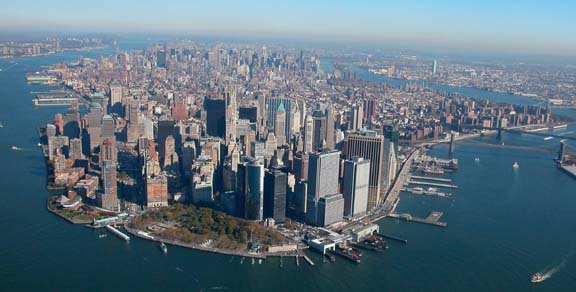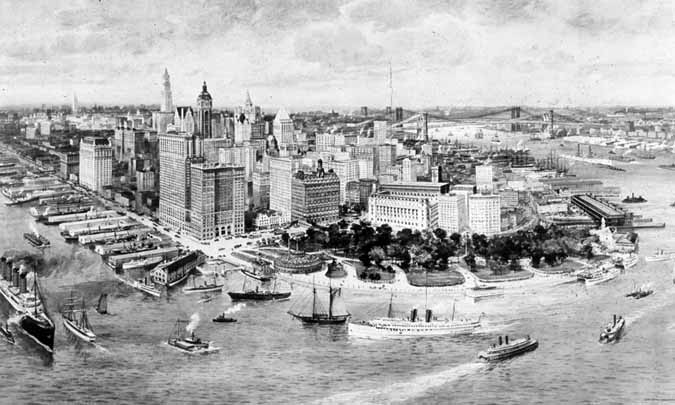lower manhattan

| click here for a gallery of Lower Manhattan skylines |
|
|
 |
| Lower Manhattan rendering, 1913 |
|
Downtown’s rich and varied history, from Colonial settlement to world-famous urban complex, spans close to four centuries. This compact area at the tip of Manhattan Island – half of it built on land reclaimed from surrounding waters of about one square mile – has played an outsized role in the development of both the city and the nation, and is rich in both memories and monuments. With the tragedy of September 11th , Downtown has once again, if unwillingly, taken center stage in the ongoing drama of New York. But those events shouldn’t obscure the remarkable trajectory of Downtown’s history, which has no parallel anywhere in the country.Centuries before the arrival of European colonists, Downtown was home to a thriving Native American culture. Broadway, Downtown’s major thoroughfare, follows the path of an ancient Algonquian trade route hundreds of miles long – and today ends at Bowling Green, where the Smithsonian National Museum of the American Indian helps keep Native American history and culture alive. The first Dutch traders arrived around 1612, followed by settlers led by Peter Minuit, first director general of the colony of New Netherland. The Dutch called their Downtown settlement Nieuw Amsterdam. Though nothing remains above ground from the half-century of Dutch rule, today’s winding streets – the famous Downtown canyons – follow the plan laid out by Dutch colonists. The English captured the colony in 1664, renaming it for the Duke of York. Downtown’s Hanover Square takes its name from the Hanoverian dynasty that still occupies the British throne. Just over a hundred years later, the English built a statue of King George III in Bowling Green, and a fence to guard it from rebellious colonists – who toppled the statue in 1776 but left the fence, which still encircles the park. Revolutionary plotters met secretly at the Queen Charlotte Tavern (named for the wife of George III). Renamed Fraunces Tavern at the end of the Revolutionary War, it played host in 1783 to General George Washington’s famed farewell dinner for his officers. New York served as the young nation’s first capital, and in 1789, Washington took the presidential oath of office at Downtown’s Federal Hall on Wall Street. The original building has disappeared, but a few blocks to the north on Broadway Washington’s original pew is preserved in Downtown’s Colonial-era St. Paul’s Chapel. New York’s prosperity grew out of its prominence as the nation’s most important port. Early 19th-century China clipper ships sailed from South Street, the “Street of Ships,” on the East River, while the blocks around Bowling Green grew into Steamship Row. Immigrants to New York first disembarked at South Street too, until a processing center opened in Downtown’s Castle Garden – predecessor of nearby Ellis Island and now called Castle Clinton. Today’s South Street Seaport preserves buildings and ships, while the skyscraper offices of the Cunard line rise above lower Broadway. Colonists and immigrants established Downtown houses of worship early on. Trinity Church, founded in 1699 as a parish of the Church of England, after the Revolution became one of the nation’s first Episcopal congregations. State Street is home to the Shrine of St. Elizabeth Bayley Seton, baptized in 1803 at St. Peter’s Church on Barclay Street. Shearith Israel, the first Jewish congregation in North America, built its synagogue on Mill Street in 1654. John Street Methodist Church is the descendant of the 1768 Wesley Chapel, the nation’s first Methodist Church; an off-shoot, the African Methodist Episcopal Zion Church, became one of the nation’s most prominent African-American congregations. William Bradford set up New York’s first printing press in 1693 at a Downtown office located on Pearl Street. In 1725, he published the first New York Gazette. His apprentice, John Peter Zenger, was jailed for libel by a colonial administration unhappy with his reporting; Zenger’s acquittal became a landmark in the fight for freedom of the press. By the 19th century, so many publications had moved to Downtown’s Park Row that it became informally known as Newspaper Row, and the surrounding area as Printing House Square. Wall Street has been synonymous with banking and finance for two centuries. The New York Stock Exchange traces its origins to an informal group of brokers meeting under a buttonwood tree on Wall Street as early as 1792, just two years after Alexander Hamilton, the nation’s first Secretary of the Treasury, issued bonds to pay the Revolution’s debt. Countless banks, insurance companies and express offices (including American Express) built Downtown headquarters in and around Wall Street. Changing technology and lack of space helped make Downtown the birthplace of the American skyscraper. Starting with the seven-and-a-half-story Equitable Building at 120 Broadway, built at the end of the 1860s, skyscraper development brought a succession of major towers, from the romantic Gothic fantasy of Cass Gilbert’s Woolworth Building to the elegant Modernism of Gordon Bunshaft’s 140 Broadway. Even with the loss of the World Trade Center’s twin towers, New York today still boasts more skyscrapers than any city in the world. And nowhere else is the skyscraper’s 140-year trajectory better represented than in Downtown. Today, with an historic center beautifully set between two rivers and a majestic harbor, stunning architecture, tall ships and the city’s most dramatic views, Downtown continues to make history, of all kinds. As we begin recovery and reconstruction, Downtown can take heart in the knowledge that it has a special and distinguished past, and that we can and will build on that past as we work to ensure Downtown’s future. |
|
|
|
|
|
|